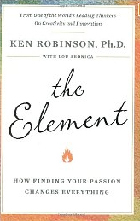Many of us grew up believing that our IQ was an important, and unchangeable, measure of our intelligence. When not provided with our scores directly, we inferred them from how we managed in school. If we sailed through, we were comfortable with the notion that we were “bright”. Those of us who struggled and felt out of place in the highly structured environment, often came away with a poor notion of our capacities in areas that seemed to matter – getting the right answer and proving how smart we were, as Sir Ken Robinson, www.sirkenrobinson.com, discusses in this animated speech to The Royal Society of Arts ( if you don’t see the UTube Video Player below, please click this link: https://www.youtube.com/watch?v=zDZFcDGpL4U)
Happily, brain science has demonstrated that we can actually expand and refine our capacities throughout our lives. Intelligence is not a fixed quantity, and we have come to realize that IQ is only one measure of a specific type of intelligence, chiefly logical thinking and deductive reasoning. Humans are complex and evolving beings, with a huge variety of capacities, including linguistic, spatial, inter-and intra-personal, kinesthetic and musical, to name a few. As Sir Robinson points out in his book, The Element, the better question to ask is How Are You Intelligent? To find the answer, you need to know a good deal more than just your IQ score. You need to find your Element, the place where the things you love to do and the things you are good at come together.
I loved school. To me, it was a haven of sanity and predictability. I understood what was asked of me and met those demands with relative ease. I had little difficulty sitting still, loved to delve deeply into information and presented a neat, organized appearance. If you’ve also guessed from this that I detested gym, you’d be right. Among other things, the reason for my positive experience with school is that my Kolbe assessment reads 9 Fact Finder, 7 Follow Thru, 3 Quick Start and 2 Implementor, a profile which aligns beautifully with the ethos of the school system.
The Kolbe A Index measures our striving instincts, or how we prefer to take action. It’s not about how smart or capable we are, or what we can and cannot do. Nor is it about personality or social style. It’s about natural behaviour and how we take action. You can determine your own Kolbe profile by visiting www.kolbe.com and taking the Kolbe A Index. The Kolbe Youth Index is for children, from grade 4 reading level up to age 17.
There are four action modes, and we’re all a combination of the four. No combination is better than another.
- Fact Finder – How we gather and share information
- Follow Thru – How we arrange and design
- Quick Start – How we deal with risk and uncertainty
- Implementor – how we deal with space and tangibles
People who initiate (a score of 7 or more) in Quick Start need a lot of variety to remain engaged. They thrive on interruptions and often bubble with a rapid stream of new ideas and concepts. Those who initiate in Implementer need to use their bodies, to work with tangible items such as physical models or tools. Today, people with these action modes are sometimes described as having ADHD (Attention Deficit Hyperactivity Disorder), and they often struggle in school.
In the era before Ritalin, children got a lot of exercise, usually unsupervised. We ran outside at recess and lunchtime, made snowmen in the winter, and in the warmer weather we played baseball, football, jumpsies, or skipped rope. We walked or biked everywhere. We didn’t have as many electronic gadgets to distract our attention. Classrooms were quieter, and the fidgetters knew they only had to hang in for another hour or so before they could get some relief.
Knowing how we take action, how we are intelligent, and what we love to do is finding our Element. It’s an evolving process of assembling puzzle pieces and gathering clues, like the Kolbe Index. A life-changing epiphany followed by a complete life overhaul is not a requirement, although some people do experience it that way. More often, however, it comes through a gradual recognition of what feels right, what activities and environments allows us to feel most engaged and vital, and significantly, it’s not always what we do for paid work.
Each of us is a complex and unique individual and no one assessment is going to capture that, but it can help us start to solve the mystery of who we are and where we are likely to flourish in the world.

